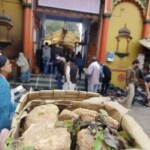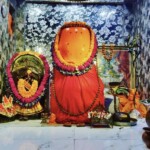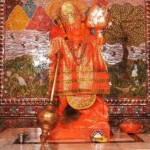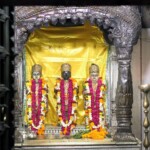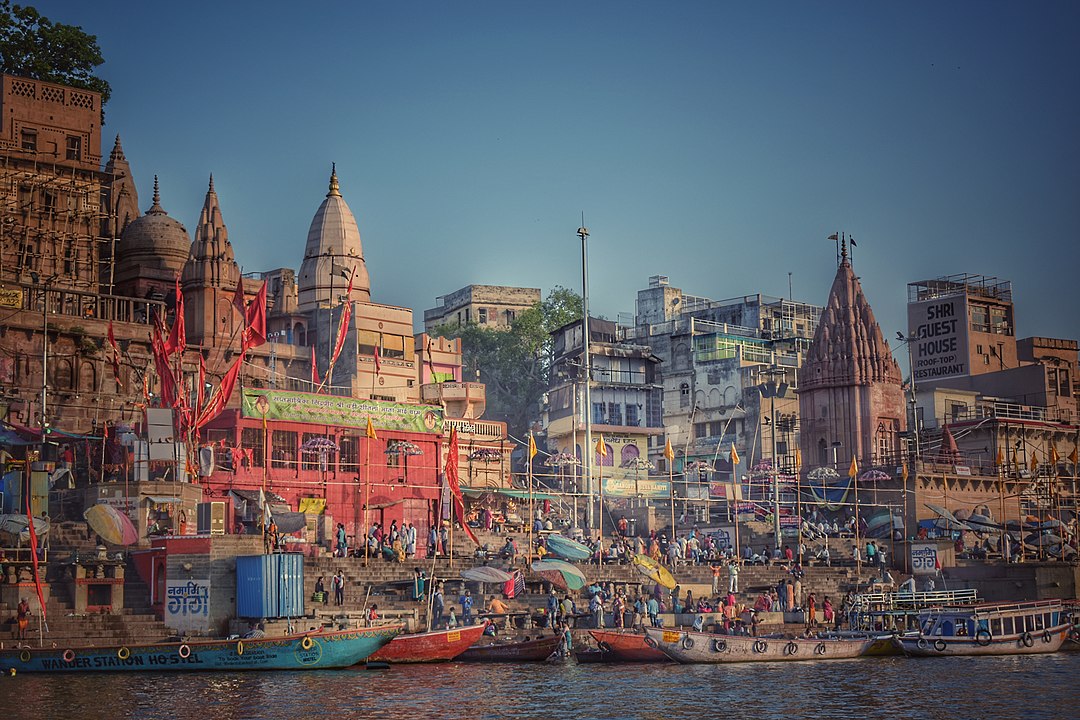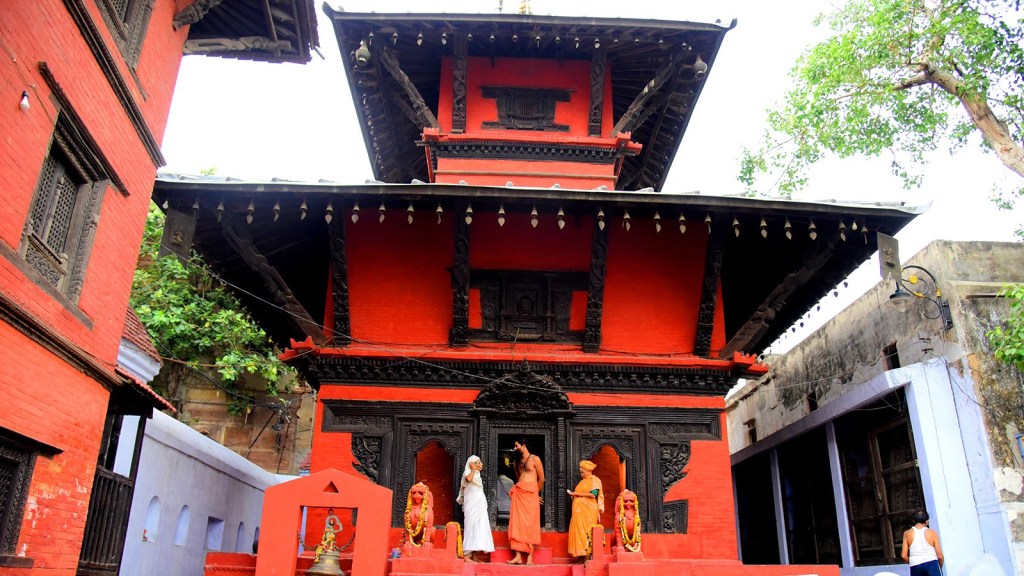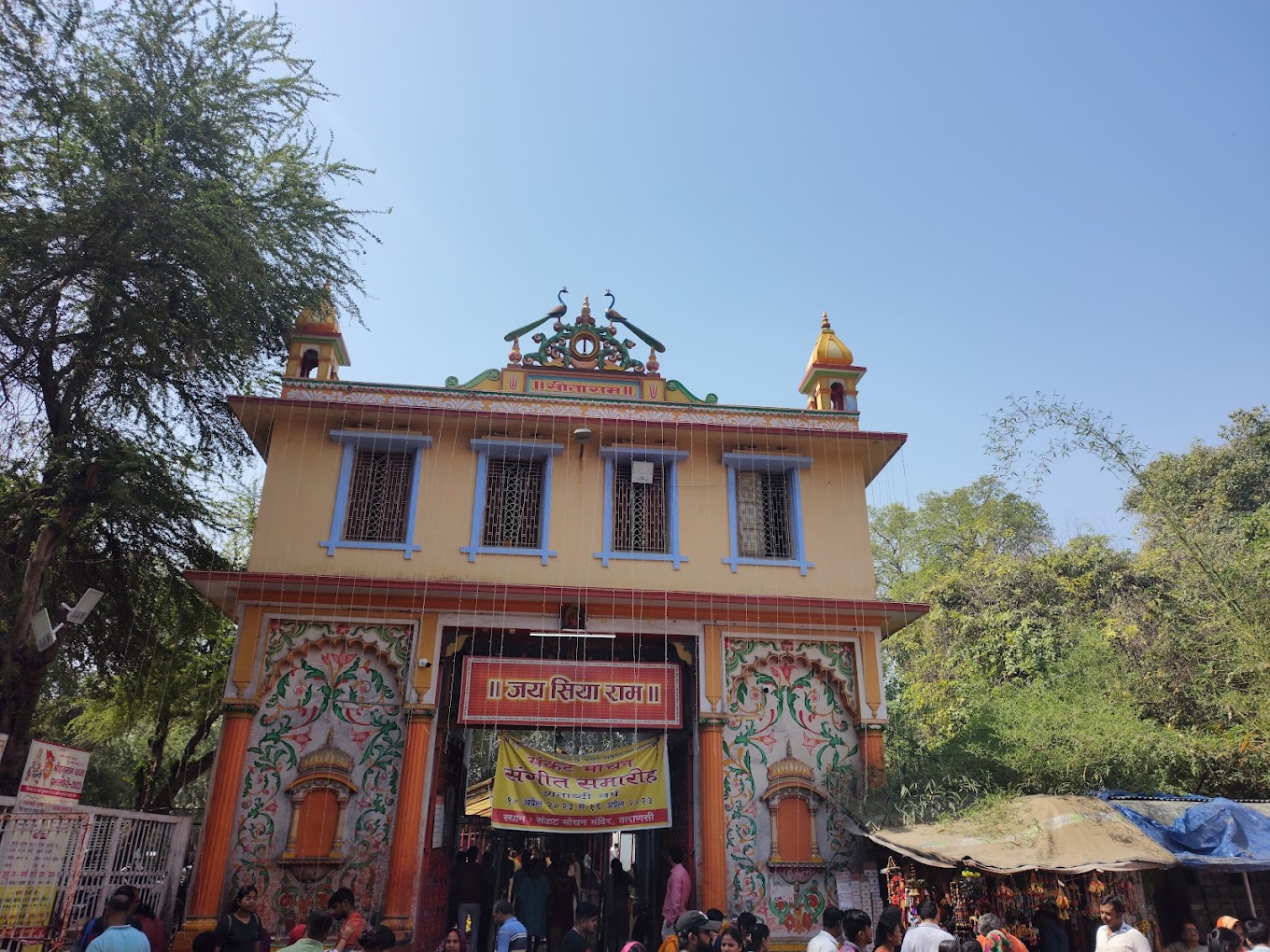
The Sankat Mochan Hanuman Mandir, situated in Varanasi, India, is not just a temple; it’s a sacred abode that holds centuries of history, devotion, and spirituality. With a rich heritage, this temple dedicated to Lord Hanuman has a lot to offer to its devotees and visitors. In this article, we will explore the temple’s history, significance, entry fee, daily rituals, and much more.
Sankat Mochan Mandir Varanasi Darshan Timing
| Day | Timing |
| Monday | 4:30 am to 12:00 pm |
| 3:00 pm to 10:30 pm | |
| Tuesday | 4:30 am to 12:00 pm |
| 3:00 pm to 12:00 night | |
| Wednesday | 4:30 am to 12:00 pm |
| 3:00 pm to 10:30 pm | |
| Thursday | 4:30 am to 12:00 pm |
| 3:00 pm to 10:30 pm | |
| Friday | 4:30 am to 12:00 pm |
| 3:00 pm to 10:30 pm | |
| Saturday | 4:30 am to 12:00 pm |
| 3:00 pm to 12:00 night | |
| Sunday | 4:30 am to 12:00 pm |
| 3:00 pm to 10:30 pm |
About Sankat Mochan Temple Varanasi
The Sankat Mochan Temple in Varanasi is a striking blend of modern and traditional architectural styles, resulting in a captivating structure. At its heart lies the primary attraction – the idol of Lord Hanuman.
One captivating feature of the temple is a statue portraying Lord Hanuman in reverence to his beloved deity, Lord Rama. This sculpture is prominently displayed in the main courtyard, alongside idols of Lord Rama, Sita, Lakshman, and the Vanara army, all paying homage to Lord Shiva.
Within the temple, there is an elliptical area exclusively dedicated to the worship of Lord Hanuman, accommodating around 250 devotees. Many followers come here to offer their prayers in the serene temple courtyard.
People from around the world visit this temple, earnestly believing that their wishes will be granted and their troubles relieved. Tuesdays and Saturdays are particularly significant, regarded as the ideal days to seek Lord Hanuman’s blessings.
During special occasions, a multitude of devotees gather to offer their prayers to Lord Hanuman and chant sacred hymns like the Hanuman Chalisa and Sunderkand.
Trivia: According to Vedic Astrology, Lord Hanuman is believed to shield his devotees from the adverse effects of Shani Grah (the planet Saturn), representing life’s challenges and obstacles, as well as Mangal Grah (Mars). Worshiping Lord Hanuman is considered the most effective way to appease Shani and Mangal.
One notable event is the Sankat Mochan Sangeet Samaroh, an annual gathering held in April. It unites musicians and artists from across the nation for classical dance and music performances. Another significant celebration is Hanuman Jayanti, which commemorates the birth of the Hindu deity Hanuman. During this event, the grand Shobha Yatra procession commences at the Durga Temple (Durga Kund) and culminates at the Sankat Mochan Temple.
Sankat Mochan Temple Varanasi Aarti Timings
4:30 am, 12:00 noon
3:00 pm, 8:00 pm
9:30 pm, 10:30 pm (Tuesday & Saturday)
12:00 night (Tuesday & Saturday)
Image Gallery of Sankat Mochan Hanuman Temple Varanasi
History of Sankat Mochan Temple Varanasi
The Sankat Mochan Temple in Varanasi has a rich and historically significant past that dates back several centuries.
Here’s an overview of its historical journey:
- Founding by Goswami Tulsidas: The Sankat Mochan Temple was founded by the revered Hindu saint Goswami Tulsidas. Tulsidas is renowned for his epic work, the Ramcharitmanas, which narrates the life and exploits of Lord Rama. He is believed to have established the temple in the early 16th century.
- Spiritual Significance: The temple was established as a place of worship dedicated to Lord Hanuman, who is affectionately known as “Sankat Mochan,” meaning the one who dispels troubles. Lord Hanuman is a central figure in Hindu mythology, known for his unwavering devotion to Lord Rama and his role in the epic Ramayana.
- Location: The temple is strategically located in the southern part of Varanasi, one of the oldest and most sacred cities in India. It is situated near the Assi Ghat, a revered spot along the banks of the Ganges River.
- Architectural Heritage: The Sankat Mochan Temple exemplifies North Indian temple architecture with its characteristic spires, domes, and intricate carvings. Despite its relatively modest size, the temple’s architecture and serene ambiance make it an attractive destination for pilgrims and tourists alike.
- Devotional Practices: Devotees have been visiting the Sankat Mochan Temple for centuries to seek blessings from Lord Hanuman, especially during challenging times. Daily rituals, bhajans (devotional songs), and aarti ceremonies are performed within the temple, fostering a spiritual atmosphere.
- Monkey Population: The temple is also known for its resident population of monkeys, believed to be descendants of Lord Hanuman. These monkeys are considered sacred and are an integral part of the temple’s unique character.
- Social and Environmental Initiatives: In addition to its religious activities, the Sankat Mochan Temple is involved in various social and environmental endeavors. It operates a charitable hospital, promotes green initiatives, and supports education and cultural events.
- Festivals: The temple hosts special celebrations during Hanuman Jayanti, which marks the birth of Lord Hanuman, and other significant Hindu festivals like Diwali and Holi.
The Sankat Mochan Temple continues to be a center of deep spiritual significance and cultural heritage in Varanasi. Its historical legacy, devotion to Lord Hanuman, and its role in the local community make it a prominent place of worship and pilgrimage in this ancient and sacred city.
Visitor Safety and Security at Sankat Mochan Mandir, Varanasi
At Sankat Mochan Mandir, Varanasi, we prioritize the safety and well-being of all our visitors. To ensure a secure and family-friendly environment, we kindly request your cooperation with the following security policies during your visit:
- Metal Detectors: All visitors are required to pass through metal detectors as a standard security measure.
- Frisking by Security Personnel: For the safety of everyone, our security personnel will conduct frisking procedures on all visitors.
- Vehicle Inspection: Security personnel will inspect all vehicles, as needed, to guarantee a safe environment within the complex.
Prohibited Items:
To maintain the safety and sanctity of the temple premises, we do not permit the following items:
- Mobile Phones
- Wallets
- Still Photography Cameras
- Plastic Bags
- Luggage
- Liquor
- Smoking Items
- Plastic Bottles
- Eatables from Outside
- Handbags
We appreciate your understanding and cooperation in adhering to these security measures and prohibitions. Your safety and the safety of all our visitors are of the utmost importance to us. We hope you have a peaceful and spiritually enriching experience during your visit to Sankat Mochan Mandir, Varanasi.
Facilities for Devotees at Sankat Mochan Mandir
We take pride in providing essential facilities to ensure a comfortable and hassle-free experience for all our devotees.
Here’s a list of the facilities available:
1. Wheelchairs:
- Charge: Free for the physically challenged, elderly, and those in need.
- Availability: Wheelchairs are available at the entrance after passing through security clearance.
2. Parking:
- We offer a paid parking facility for your convenience.
- Open from: 9:30 am to Gate Closing.
- Restrictions: The parking area is exclusively for visitors; cargo or goods vehicles are not permitted.
- Please note that parking is on a first-come, first-served basis, and vehicles are parked at the owner’s risk.
3. Lost & Found:
- If you misplace any belongings during your visit, our Lost & Found facility is conveniently located near the entrance gate after passing through security clearance.
We aim to enhance your visit to Sankat Mochan Mandir by providing these facilities, ensuring that your spiritual journey is as comfortable and pleasant as possible.
Best time to Visit the Sankat Mochan Hanuman Mandir Varanasi
The best time to visit the Sankat Mochan Hanuman Temple in Varanasi is during the early morning or late afternoon. These times are ideal for a serene and spiritual experience at the temple.
Here’s why:
- Morning Visit (Sunrise): Visiting the temple at sunrise is considered the most auspicious time. The peaceful ambiance, the chanting of prayers, and the cool morning air create a deeply spiritual atmosphere. It’s less crowded compared to other times of the day, allowing for a more intimate experience.
- Late Afternoon Visit (Before Sunset): Another excellent time to visit is in the late afternoon, shortly before sunset. The temple is often less crowded during this time, and you can witness the aarti (ritual of offering light to the deities) performed at dusk. The setting sun and the divine rituals create a magical environment.
- Avoid Midday: It’s advisable to avoid visiting the temple during the midday hours, particularly during the scorching summer months. Varanasi experiences extreme heat during the day, which can make the temple premises uncomfortably hot.
- Tuesdays and Saturdays: If you have the flexibility to choose specific days, Tuesdays and Saturdays are considered especially auspicious for seeking the blessings of Lord Hanuman. Many devotees flock to the temple on these days, so expect larger crowds and a more vibrant atmosphere.
- Festivals and Special Occasions: If you’re interested in experiencing the temple during its most festive moments, plan your visit during Hanuman Jayanti (celebrating Lord Hanuman’s birth) or the annual Sankat Mochan Sangeet Samaroh (a music and dance festival). These events offer a unique and lively cultural experience.
- Plan According to Personal Preference: Ultimately, the best time to visit the Sankat Mochan Hanuman Temple depends on your personal preferences. If you prefer a quieter and more contemplative experience, mornings and late afternoons are ideal. However, if you want to immerse yourself in the vibrant religious and cultural aspects, consider visiting during special festivals or auspicious days.
Remember to dress modestly and respectfully when visiting the temple, and be mindful of the local customs and traditions.
How to Reach the Sankat Mochan Temple Varanasi?
Reaching the Sankat Mochan Temple in Varanasi is relatively straightforward, as the temple is a well-known and easily accessible religious site.
Here are several ways to get to the Sankat Mochan Temple:
By Air:
Lal Bahadur Shastri International Airport (Varanasi Airport): If you’re arriving by air, Varanasi’s Lal Bahadur Shastri International Airport is the nearest airport. From there, you can hire a taxi or take a pre-paid taxi to reach the temple, which is about a 30-45 minute drive away.
By Train:
Varanasi Junction (Varanasi Cantt): Varanasi has a major railway station, Varanasi Junction, also known as Varanasi Cantt. It is well-connected to various cities across India. Once you arrive at the station, you can take a taxi, auto-rickshaw, or cycle rickshaw to reach the Sankat Mochan Temple. The temple is approximately a 15-20 minute drive from the railway station.
By Road:
Local Transport: Varanasi has an extensive network of local buses, auto-rickshaws, and cycle rickshaws. You can hire an auto-rickshaw or cycle rickshaw to take you directly to the temple. Remember to negotiate the fare before starting your journey.
Private Vehicle: If you’re traveling with a private vehicle or a hired taxi, you can use GPS or ask for directions to the Sankat Mochan Temple. It’s a well-known landmark in Varanasi, so locals can guide you.
By Boat:
Ganges River: For a unique experience, you can take a boat ride on the Ganges River. There are several ghats in Varanasi, including Assi Ghat, near the Sankat Mochan Temple. You can hire a boat and enjoy a scenic ride along the river to reach the temple.
Remember that Varanasi’s narrow lanes can be crowded, so plan your journey accordingly and be prepared for some traffic congestion, especially during peak pilgrimage seasons. Also, ensure that you dress modestly and respectfully when visiting the temple, as it is a sacred place of worship.
Google Map for Sankat Mochan Hanuman Temple Varanasi
FAQs about Sankat Mochan Mandir, Varanasi
Is there an entry fee to visit Sankat Mochan Mandir?
No, there is no entry fee. The temple is open to all.
Are there any specific dress code requirements for visiting the temple?
While there is no strict dress code, it's advisable to dress modestly out of respect for the sacred environment.
Can I take photographs inside the temple?
Photography rules may vary, but generally, photography inside the temple may be restricted. Please check with the temple staff.
Is there any specific protocol for participating in the aarti ceremony?
Visitors are welcome to participate in the aarti ceremony. It's customary to offer flowers or prasad during the aarti, and seating arrangements may be in place.
Are there any restrictions on who can visit the temple?
The temple is open to people of all backgrounds and faiths. Everyone is welcome to visit and seek blessings.
Is there a specific time for the Hanuman Jayanti celebration at the temple?
Hanuman Jayanti is celebrated with enthusiasm, and specific timings can vary from year to year. It's advisable to inquire about the schedule during your visit.
Are there accommodations or hotels near Sankat Mochan Mandir for visitors to stay?
Yes, there are several hotels and accommodations in Varanasi, catering to various budgets. You can find options near the temple as well as in other parts of the city.
Is there a canteen or food facility available for devotees at the temple?
Many temples in Varanasi have prasad distribution centers where visitors can partake in sanctified food offerings. Please check with the temple staff for details.
Can I bring my children to the temple?
Children are welcome to visit the temple. However, it's advisable to supervise them, especially during crowded periods.


